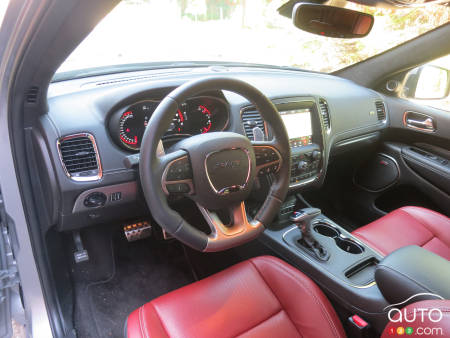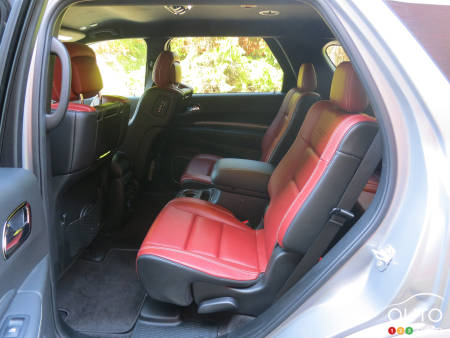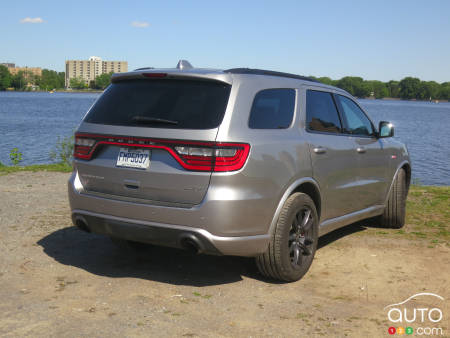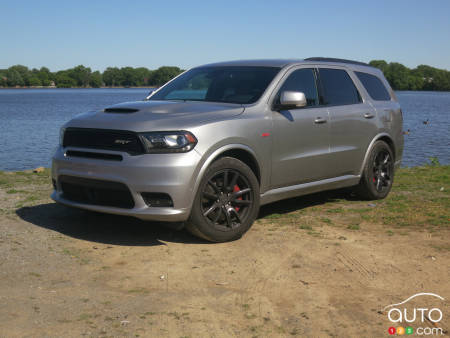The Durango midsize SUV from dodge first saw the light of day in 1997. That first generation represented Chrysler’s response to the Ford Explorer and other SUVs that were based on pickups of the period. In the case of the Durango, its first two generations were based on the Dakota truck. When this pickup model was discontinued, Chrysler (now FCA) decided to turn the Durango into a larger SUV, built this time on a whole new platform. Thus it was reborn as a vehicle derived from the 2011 Jeep Grand Cherokee, but with a longer wheelbase. So while the Jeep offered five seats, the Durango included room for seven. Also worth noting is that this platform had been developed in large part by Daimler for its Mercedes-Benz GL, M and R SUVs; this was during the period of the Daimler-Chrysler partnership. The platform actually was first used on Chrysler’s pickups.
That Daimler-Chrysler partnership ended when Fiat acquired Chrysler, but the platform is still in use, the Durango right along with it. The large SUV is back again for 2018 with the same chassis it had back in 2011. FCA now offers the Durango in various trims, including the base model, that come with the 3.6L Pentastar V6, or else to the more powerful – and now legendary – 5.7L HEMI V8. The latter engine has even been offered in the 360-hp R/T versions.
Given the advances made recently by competitors in the segment, FCA had to make some adjustments for 2018. The automaker presents us with the Durango SRT with a 6.4L HEMI V8, delivering an impressive 475 hp and 470 lb-ft of torque. Now, some like to accuse the American manufacturers of sticking powerful engines under the hood of their vehicles without bringing technical improvements to match. This is definitely not the case here!
Dodge’s engineers had previously delivered some performance versions of the Durango, for instance the R/T. But they’ve outdone themselves with the Durango SRT (for Street Racing Technology). From the outside, this version is distinguishable by its black front grille, unique except for its resemblance to the one that adorns the Charger SRT. The headlights have also been redrawn; thses LED units are more slender and more aerodynamic than before. The front end and bumpers have also been revised, while the new hood sports air ducts that are actually functional, in case you’re wondering.
The four-door body is, as mentioned, the same as it’s been since 2011. In back, changes are minimal, although in the SRT version, two imposing exhaust tubes are stocking out of the bottom end. The rear lights are also remarkable, especially at night when the act of braking makes LED lighting do the rounds around the light cluster.
The interior of the Durango SRT manages to be both modest and spectacular. Modest because it’s been virtually the same for the entire third generation, but spectacular because Dodge’s designers have been able nonetheless to add modern finishes that are easy on the eye. The dashboard remains unchanged in the new edition, but Chrysler’s default instrumentation has been replaced by a comprehensive array of attractive digital elements. In the middle, you get an imposing screen used to access the radio, navigations and the many adjustments that can be made to the Durango’s suspension and road handling. The driver can also access there the commands for the Launch system, designed to enable aggressive acceleration without the wheels spinning (every drag strip racer’s dream). By the way, FCA’s navigation and communication system, Uconnect is one of the simplest to use in the opinion of quite a number of automotive journalists!
The Durango SRT has two very comfortable front bucket seats with lateral support, which do a good job of conducting the lateral forces generated by the vehicle’s road handling to the front occupants in very pleasant fashion. The central console does seem pretty massive, but it ably houses the gear knob and supports cups very firmly. The steering wheel, meanwhile, resembles that of a racing car, and offers a good grip as well as a number of (redundant) commands to make manipulating controls while driving a breeze.
The two rear seats are just as comfortable and offer support as well. Occupants there get ample legroom, and will surely enjoy the (available) screens located on the back of the front-seat headrests. And since the Durango is built on a longer platform than the Grand Cherokee, you’ll find a third row of seats in back, able to hold two more passengers. Though there is sufficient space to take in adults, the space is unsurprisingly better suited for children. Throughout the cabin, visibility is fairly good. As for cargo space, it obviously grows much bigger when that third row is folded down, and is accessed via a power hatch.
Under the hood
If you’re interested in the Durango, clearly you’ll want to know more about its mechanics. As mentioned, the SUV comes with the 6.4L HEMI V8, which delivers its impressive power with the help of a mechanical compressor or turbocharger. In the older automotive jargon, you would describe this engine has having 392 cubic inches (hence the 392 inscription on the front wings), like the HEMI engines of the 1950s. This modern engine does benefit from MDS (Multi Displacement System) technology, which neutralizes four of the eight cylinders when at highway cruising speed in order to save on gasoline - obviously something not possible in the past.
The engine is combined with an 8-speed automatic transmission than the driver can manipulate manually thanks to the pallets placed on the back of the steering wheel. The combo transmits power to the wheels via an all-wheel drive system. The tires on our test model were imposing Pirelli Scorpion Verde tires (295/45 ZR 20). The adjustable suspension is by default composed of springs that are 3% firmer in front, 16% firmer in back with more-rigid stabilizer bars and appropriate Bilstein shocks. As for braking, FCA is included Brembo systems with six-piston calipers and 38-cm discs in front, and 4-piston calipers and 35-cm discs in back.
The big surprise for 2018, though, is that the Durango SRT can pull up to 8,700 lbs (3,950 kgs), which is highly impressive! And this means you get power, performance, room for 6 AND an elevated towing capacity all rolled into one.
On the road
Spending a week at the wheel of this Dodge Durango was an exhilarating experience, though it wasn’t without its inconveniences. Among the advantages, the acceleration was impressive – doing the 0-100 km/h took around 6 seconds – and passing was done with confidence. But it’s important to keep a tight rein on the right foot when driving this Dodge in traffic, because it can sometimes jump ahead at the slightest touch of the pedal. And then, there are the exhaust sounds! The driver is very likely to love them, but the passengers less so!
It’s possible to choose the firmness of the suspension using the menu on the central screen; you can opt for Sport, Track, Snow and Eco, but I settled on Auto, which renders the drive a little more civilized (I should add that the Track mode made life virtually unbearable for passengers). Those settings notwithstanding, I suggest you delete any ideas you have of taking this Durango off-road. It sits too low to the ground, the tires are too large and anyways that’s not the vehicle’s mandate.
On the other hand the all-wheel drive is your friend when driving aggressively, especially when the pavement is wet. I’m sure it will be even more appreciated in wintertime conditions. Of course, the size of the SRT’s tires means changing them for winter-worthy ones will be an expensive endeavour. Using the Durango SRT in the city, meanwhile, requires a bit of patience given its imposing size. You do get indicators to help you assess your proximity to other vehicles. Thank goodness for the backup camera…
You shouldn’t and surely don’t expect miracles on the fuel consumption front, even with that aforementioned MDS technology. We completed our test drive with an average 18L/100 km, in mainly urban driving, while the onboard computer indicated 17.9! Keep in mind as well that the Durango SRT comes with a healthy price tag. Its base price is $73,345, but add a few options, like the ventilated front seats ($1,500), the Tech package with forward collision alert, adaptive cruise control and blind spot monitor ($1,450), and especially the entertainment option for rear-seat passengers ($2,150), not to mention the towing package ($825), the premium interior finish option with carbo-fibre elements ($2,995), the rear console ($250), the black roof rails and black alloy wheels ($995), the federal green levy ($1,000) and the federal A/C tax ($100), and then factor in $1,895 for transport and prep, and you get a final bill of $86,705.
This certainly puts it in a rarified class, but it still compares favourably with competitors like the Mercedes-Benz GLS63, BMW X5 M and Range Rover Sport SVR (this last doesn’t have a third row of seats).
For fans of American-built vehicles, the Durango SRT is nothing less than a modern-day muscle car with room for 6! One thing’s for sure, this vehicle is unlike just about any other you’ll find on the market! FCA, by the way, has just unveiled a “police” version of the Durango, dubbed the Enforcer, which is expected to go to market at the end of summer 2018...






